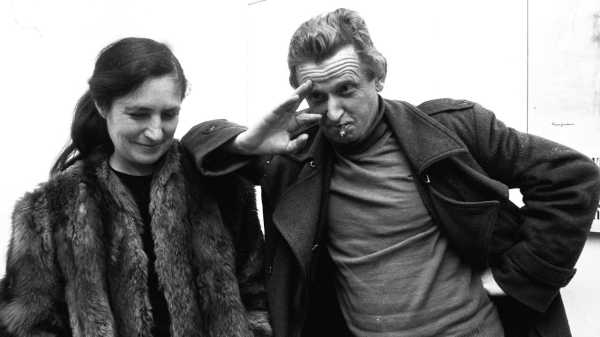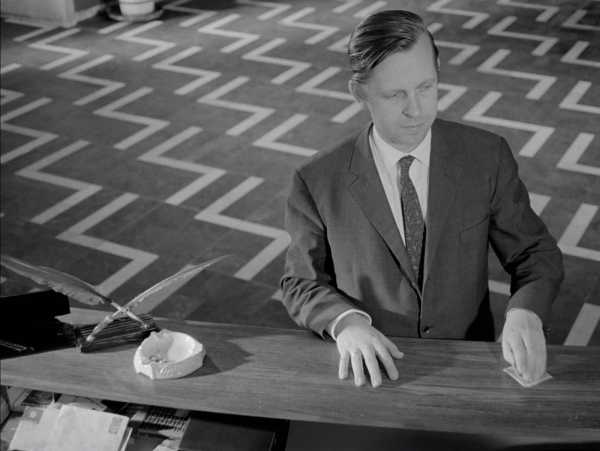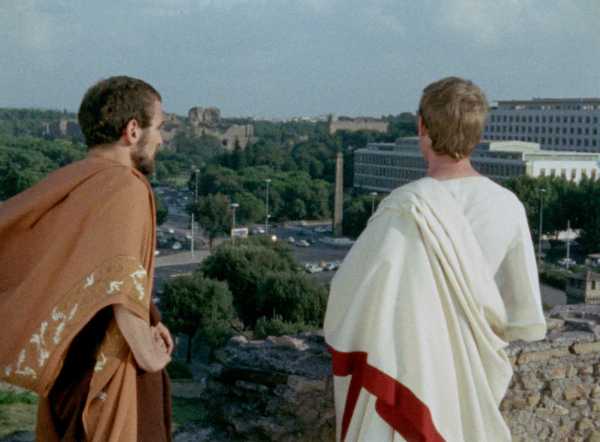
Jean-Marie Straub, one of the great filmmakers of the French New Wave and one of the most secretly powerful influences in the modern cinema, died on Sunday, at the age of eighty-nine, in Rolle, Switzerland. (Rolle is the same small town where Jean-Luc Godard, who died in September, lived since the nineteen-seventies.) Straub’s work and his life illuminated the very idea of what it meant to be a part of the French New Wave, even at some geographical distance; he both created and personified a passionate, radical critique of the world of movies and of the world at large. He’s one of the least known of great filmmakers—he never had a hit or sought one. Yet he was one of the most original filmmakers of his time, a sort of Marxist Éric Rohmer, a word-centered director whose style is instantly recognizable and whose methods are as distinctive as his films. His influence on the present-day art film is as subtle as it is deep and widespread.
Straub was born in Metz, in 1933—which is to say, in Lorraine, as in Alsace-Lorraine, a part of France that had been a longtime flash point of war between France and Germany. Germany reannexed and reoccupied Alsace-Lorraine in 1940, until it returned to France after the Second World War. Straub grew up there during the war and stayed through his early twenties. As a filmmaker, he was an internationalist: he also lived and made films in Germany, Italy, and Switzerland, and conceptualized a cinema that transcended national boundaries by way of intellectual ideals, political resistance, and the development of cinematic forms and practices that incarnated those ideals. Relatively few of Straub’s films were made in France, and few of them are in French. And yet his life’s work is nonetheless inseparable from the personal connections and the shared ambitions of his French contemporaries and peers—and, for that matter, from their French elders, predecessors, and cinematic heroes.
A precocious movie lover and an aspiring critic, Straub often visited Paris in the early fifties, and met Godard, Jacques Rivette, and François Truffaut at the Cinémathèque. During that same period, he ran a film club in Metz, bringing in the young Cahiers critic Truffaut and the magazine’s co-founder André Bazin to introduce films. Straub moved to Paris in 1954, where he met a fellow cinephile, Danièle Huillet, and they quickly became a couple. She was rejected from film school; he got in but was kicked out in three weeks. Straub worked as an assistant on other people’s films, including a short by Rivette and, decisively, Robert Bresson’s “A Man Escaped,” from 1956. Straub and Huillet had written a script for a film about Johann Sebastian Bach; he offered it to Bresson, who suggested that the couple make it themselves. In 1958, Straub, refusing to serve in the French military during the Algerian War, went into exile in Germany; Huillet followed him, they married, and they tried and failed to raise money to make the Bach film. While in Germany, they met the writer Heinrich Böll and adapted his short story “Bonn Diary” for their first short film, “Machorka-Muff,” as well as his great novel “Billiards at Half-Past Nine” for their first feature, “Not Reconciled,” in 1965—one of the most original and daring of all first features.
In “Not Reconciled,” Huillet and Straub boiled the hefty, multigenerational novel down to a compressed and fragmentary fifty-five-minute film. With abrupt juxtapositions replacing guided flashbacks, the film sets out one family’s private experiences of German history, from the early twentieth century to the present, with a particular emphasis on the local, personal brutality of Nazis during the Hitler regime and on how easily many of them had been rehabilitated and even honored in the postwar years. The film’s subtitle, “Only Violence Helps Where Violence Reigns,” reflects the details of Böll’s narrative as well as how the filmmakers shift the story’s focus, transforming its literary allusiveness into an abrupt, declarative materialism—albeit one that’s illuminated with images of an enduring symbolic power. (Richard Roud—one of the founders of the New York Film Festival, where “Not Reconciled” was screened, in 1965—was present at the movie’s première at the Berlin Film Festival; in his 1972 book “Straub,” he describes the Berlin audience’s “unbelievably hostile reaction” to the movie.)

A still from “Not Reconciled.”Photograph courtesy Grasshopper Film
The crucial link between Straub and the core of young Cahiers critics who became French New Wave directors is historicism: the influence of classic films on their work and the adaptation of classical movie styles for their own films, as modernistic or complex as they may be. There is a vital tradition of literature-based, language-centric French cinema, seen in the work of Sacha Guitry, Jean Cocteau, Marguerite Duras, Bresson, and Rohmer—filmmakers who made images based on literary sources and infused with literary language. Straub was the youngest master of this lineage.
In particular, Straub’s cinema is based on that of Bresson, in ways that reflect an ingenious reinterpretation of his work. The first, most conspicuous connection is the rigorous austerity of the images. Like Bresson, Straub understands ideas physically, and the intense restraint and spareness of the images distill ideas to corporeal facts. This concept is an inherently ideological one. For Bresson, whose films are inspired by his Catholic faith, it’s a way of filming the incarnation of divinity in human life, the Word made flesh. For Straub, the austerity of his images is a means for rendering the abstractions of class conflict and political power in direct dramatic terms, for the physical expression and manifestation of complex historical realities—the flesh made word. Straub and Huillet’s methods emphasized the bodily presences of their talking subjects and reconceived those presences in terms of the history and the intellectual forces that shaped them. (The couple’s fanatical reliance on direct sound, on what’s recorded while filming, is a key element in their cinematic materialism.)
A second connection to Bresson is that Straub and Huillet based most of their films on preëxisting literary or historical texts. Moreover, they often built their own relationship to those texts—the sheer practical fact of adaptation, and the connection of the texts to the historical moment of the filming—into their movies. Third, they reimagined and refashioned the notion of cinematic performance. Like Bresson, Straub and Huillet worked mostly with nonprofessional actors. Bresson devised a distinctive method for directing them, filming dozens of takes in order to strip them of dramatic expression; Straub wasn’t averse to dramatic expression per se, only to its conventional forms and uses. He often rehearsed extensively with his nonprofessionals, achieving results that are as theatrically precise as they are starkly, fiercely expressive.
Straub and Huillet were finally able to make their Bach film, “The Chronicle of Anna Magdalena Bach,” in Germany, in 1967, during politically turbulent times—and, though the film is a high-culture, historical costume drama, it seethes with the defiant spirit of the time. Anna Magdalena Bach was played by Christiane Lang, a singer whom Straub had seen in Paris. Johann Sebastian Bach was played by the eminent harpsichordist and organist Gustav Leonhardt, other musicians in Bach’s circle were played by other real-life musicians (such as Nikolaus Harnoncourt and August Wenzinger), and their performances of Bach’s music were filmed in uninterrupted long takes that, in effect, turned the fictional bio-pic of Bach and his family life into a documentary about historically informed performance of Bach’s music. Yet the filmmakers’ vision of Bach’s life, centered on the institutional hostility that he faced from stiff-necked religious and civic authorities, is an exemplary tale of aesthetic idealism as an enduring form of political resistance. The film is a work of artistic archeology, recovering Bach’s radical intransigence from the genteel luxuries of the culture industry.
Classical music and classical culture in general were at the center of Straub and Huillet’s films—and were put to similarly confrontational uses throughout their careers. They made a movie of Arnold Schoenberg’s unfinished opera “Moses and Aaron” in 1975, filming on location in Italy. The story’s conflict between the tongue-tied prophet and his demagogic brother served as an allegory for the severely oppositional cinema of Straub and Huillet against the solid-gold delusions of commercial filmmaking. Two decades later, they made an indoor, studio-bound version of Schoenberg’s twelve-tone comic opera “Von Heute auf Morgen,” which they turned into a repudiation of modern urban bourgeois immorality. In 1969, they filmed Corneille’s 1664 play “Othon,” with the film critic Adriano Aprà in the lead role (Straub played a role, too), doing so in a way that even more radically links the dramatic fiction to nonfiction filmmaking, staging the historical tragedy of ancient Rome on location in the modern city. The film’s elaborate title, “Eyes Do Not Want to Close at All Times, or, Perhaps One Day Rome Will Allow Herself to Choose in Her Turn,” suggests the absurdity of court intrigues as a substitute for democratic rule—and that such an absurdity was indeed taking place in contemporary Italy under the guise of bourgeois democracy.
The distance that Straub and Huillet placed between their own work and the general run of commercial movies nonetheless belies their deep knowledge of, and devotion to, their self-elected cinematic heritage. They self-consciously place their films in that heritage, albeit in ways that are as original as their visual styles and choices of subject. Therein hangs a tale. In 2001, I was in Paris, doing research for a critical biography of Jean-Luc Godard. I interviewed Straub about his long-standing artistic and personal connections to Godard. (Godard, in a 1965 Cahiers interview, had been one of the early enthusiasts for “Not Reconciled,” and helped to finance the Bach film.) In our discussion, Straub carefully distinguished his own approach to film history from Godard’s. At the end of the interview, he invited me to a screening that night of his 1992 film “Antigone” and asked me to call him back after I’d seen it.
When I saw this hieratic version of the play, I felt that the remarkable film—based on Bertolt Brecht’s adaptation of Friedrich Hölderlin’s translation of Sophocles’ tragedy—was a contemporary version of a John Ford Western. When I called Straub back, he agreed with me. There’s nothing in this “Antigone” that physically or textually refers to any Ford film or to the American West, but they share the thematic foregrounding of the hypocrisy of tyrants, their sway over the mob, and the tragic solitude of a visionary of justice. A film that I consider to be his supreme masterwork of later years, “Sicilia!,” from 1999, based on a novel by Elio Vittorini and set in the age of Mussolini, offers a piercingly political view of the carnivalesque element of day-to-day rural Italian life. It also offers a vision of the inextricable connection between misogynistic morality and Fascist ideology. Its concluding flourish of street-theatrical comedy is a kind of revision of the tones and themes of Federico Fellini’s films.
Asked in 1997 how the couple divided their work, Huillet said, “He works more on the framing, the image, and I take care of the organization, the production.” Straub added, “We do the editing together, but I’m not allowed to touch the machine.” The couple hardly engaged in what’s familiarly known as personal cinema, although their short film “Lothringen!” (German for the province of Lorraine), from 1994, summons Straub’s memories of the German Occupation of his home town of Metz, by way of the story of a young French woman’s resistance, in 1872, to the city’s Germanic occupation after the Franco-Prussian War. (Straub and Huillet also took part in another kind of personal cinema: the portrait film “Where Does Your Hidden Smile Lie?,” the Portuguese director Pedro Costa’s depiction of the couple at work on the editing of “Sicilia!”) Huillet’s last script with Straub was for “Itinerary of Jean Bricard,” released in 2008. (He completed the film after her death, in 2006). Based on a nonfiction book by Jean-Yves Petiteau, it’s a story of the French Resistance that resonates with Roberto Rossellini’s 1946 film, “Paisan.” Straub’s 2009 film “The Witches—Women Among Women,” adapted from one of Cesare Pavese’s “Dialogues with Leuco” and set in the Homeric age, is an echo of another classic film—George Cukor’s “The Women,” from 1939.
Just to scroll through the sources for many of Straub’s films evokes a cinema that gathers and transforms a high-culture European heritage into an aesthetic of resistance: the list includes Dante, Cézanne, Montaigne, Mallarmé, Kafka, Duras, and Engels. It also reflects the isolation from the film industry that Straub and Huillet experienced. Between the force of his ideological commitment, the strength of his aesthetic vision, and the distance he kept from the outside influences of commercial film producers and well-known actors proposing projects, Straub deepened his long-standing style without widening it. He ended up in the paradoxical position of becoming an incarnation of a virtual brand—a living logo of an ideal of cinema that all too easily became detached from the revolutionary premise that gave rise to it.
Nonetheless, though Straub spurned the current cinema’s major trends and personalities, there is something essentially Straubian in many of the best recent movies. His younger contemporaries reflected his influence directly, whether in the relationship between language and landscape in the films of the late Chantal Akerman, the declamations of nonprofessional actors in Costa’s films, or the text-based historicism of Albert Serra. Whether or not Terrence Malick or Sofia Coppola have seen films by Straub and Huillet, the couple’s cinematic DNA has taken root in Malick’s tactile idealism and Coppola’s idea-imbued cityscapes. My favorite image in Kenneth Lonergan’s extended cut of “Margaret,” a long panning shot across the rooftops of Manhattan, could have been borrowed from Straub. Such young present-day filmmakers as Ricky D’Ambrose and Matías Piñeiro develop the historical scope and cultural reach of their intimate dramas by way of Straubian philosophy and style. Above all, wherever the cinema challenges unjust authority, Straub’s spirit urges it onward—to embody its defiance in a distinctive aesthetic, an original mode of production, and a sense of history to match its political ideals. The legacy he leaves is a very tall order.

A still from “Eyes Do Not Want to Close at All Times, or, Perhaps One Day Rome Will Allow Herself to Choose in Her Turn.”Photograph courtesy Grasshopper Film
In my 2001 telephone interviews with Jean-Marie Straub, I had no way to record the calls. I took rapid notes while we talked, omitting chitchat and, above all, omitting my own questions and remarks, merely summarizing them. The premise of the interview was his personal and artistic relationship with Godard, but Straub very much wanted to talk about his own work in regard to Godard’s, and then about his own working methods, period, and to offer his own perspective on the state of the cinema. My notes left what, in retrospect, is an ambiguity at the very end: Is he still criticizing film students, or is he changing the subject to criticize two of the most prominent Hollywood directors? In context, the former; in tone, the latter. I wish that I had asked; above all, I wish that one could ask him now.
On the end of cinema: Hollywood is no longer Hollywood; the Soviet cinema no longer exists. Hollywood is now nothing but an association of real-estate and oil companies. It’s nothing but individuals. . . . The only one who’s doing something interesting is [Robert] Altman.
On marketing: Criticism has nothing to do with a film’s success. It’s what happens six weeks before the release—the advertising. Most of the French films that come out now have an advertising budget that’s bigger than their production budget. Without that, the film will only be seen by ten thousand or three thousand people.
I was subsidized once by the Centre National du Cinéma [a French government agency], for “Moses and Aaron.” I never had a penny from [the TV channels] Canal+ or Arte. I wasn’t subsidized for my last three films. Fortunately, there’s the German Channel 3. The films that get subsidized are the ones that are already commercial. That’s the problem with the cinema today.
On Godard: I’ve never made a film with reference to the cinema. . . . With Godard’s first films, that’s why people liked them. It’s not the films they liked; it’s their ingredients. . . . Our films are also anchored in the tradition of the cinema, but in a way—it’s a word I don’t like—but “deeper.”
He recently wrote me a beautiful letter. He had seen an old film of mine, “From the Cloud to the Resistance” [1979]. He said that it’s a film that he’d like to have made, but he hadn’t had the courage to make. He’s my friend—I don’t want to talk about him, like, “I like this film, I don’t like that film,” those sorts of things. At the time when everyone was going crazy over Godard’s first films, I didn’t especially like them. I wouldn’t say that I have much in common with him as a director. What’s important is that, at the time when my [German-language] film “Not Reconciled” [1965] was threatened with seizure and destruction, Jean-Luc Godard gave five interviews to five German newspapers to say, “Instead of being punished, Jean-Marie Straub deserves to be rewarded for having had the courage to make a movie without having rights.” [Straub made the film before securing rights to the film’s source text, Heinrich Böll’s novel “Billiards at Half-Past Nine.”] That’s what I admire about Godard—his moral sense, the courage of provocation.
On raising money for his productions: It consumes lots of energy; it wears on the nerves; it wears on the bones; it wears on the muscles. We have to pay the laboratories—we pay more than the big films do. . . . The actors are paid badly, but at least they’re paid. They can rehearse. They need it. Even [Michel] Piccoli. When Jean-Luc saw “Antigone,” I told him that the woman who plays Antigone is a nonprofessional. He said, “No nonprofessional actor can act like that.” We did about ten performances in the theatre a month before the shoot, but that’s a luxury. It takes patience. We manage to do it because we make films that are connected to theatre. If you tell the same actors that they’re doing a film, they rehearse ten days, whereas in the theatre, they have to be able to hold up onstage for an hour and a half or two hours—they’re obligated to work for months. Otherwise, they don’t work.
On making films that aren’t tied to the theatre: “[The Death of] Empedocles” [1987] wasn’t tied to the theatre. We worked on the text for a year and a half, once every ten days, every eight days, every three days, with the actors. One of them lived in Hamburg, one in Paris, one in Rome. So we got together once or twice a month. Working that way, spaced out over lots of time, is nearly better.
On American actors: Twenty years ago, the Americans were better. They’re very precise, less overflowing. With the [rise of the] Method, actors are no longer available to the text. It becomes the lonely-hearts column, sentimental novels.
On takes: A text must be the clearing in a forest; there are various possible interpretations, and everyone has to choose one of them. We shoot until we’ve done a good take, then we do another for protection, in case there’s a problem with the laboratory or the film stock. Sometimes the first good take is the seventh or the third or the second or the tenth. After having done a good take, the actors feel much freer, they take more risks, they’re relaxed. So we shoot again—sometimes to the fifteenth or the thirtieth—to get two good takes. Fatigue sets in, but, because of the work that they’ve done, they manage to re-master the text. Actors have a myth of spontaneity.
With “Antigone,” I asked them to control their gazes while they’re speaking the text. They said that, on the stage, they always improvised them. They said that they wanted to keep their spontaneity. It took a month and a half to calm them down. Afterward, they went at it with lots of enthusiasm; they acted—they said, “I made a mistake.” I said, “No, it’s fine.” They said, “Yes, really, a syllable too soon, a consonant too soon.” I told them, “I didn’t want to tell you.” They knew it better than I did. We required them to come out of their laziness. They talk about spontaneity, but there’s no freedom that goes beyond the methodical; Bresson already said so. Their spontaneity is to hide the lack of work, the lack of heart, the lack of mind.
On critics: They no longer have a frame of reference. They don’t know who Renoir, Tati, John Ford, Dreyer are. Or they’ve seen one or two films but don’t see the importance. They’re too devoted to the films that are in fashion. In schools in the United States—for example, when I showed “Moses and Aaron” in San Diego, there were students who’d never seen a film by Griffith, nor the ten-minute-long Essanay films by Chaplin. Spielberg, Coppola; their knowledge of cinema begins with Fellini and Bergman. That’s what impressed them. Not Renoir. They don’t know the cinema. Fellini’s not bad, but . . . ♦
Sourse: newyorker.com






